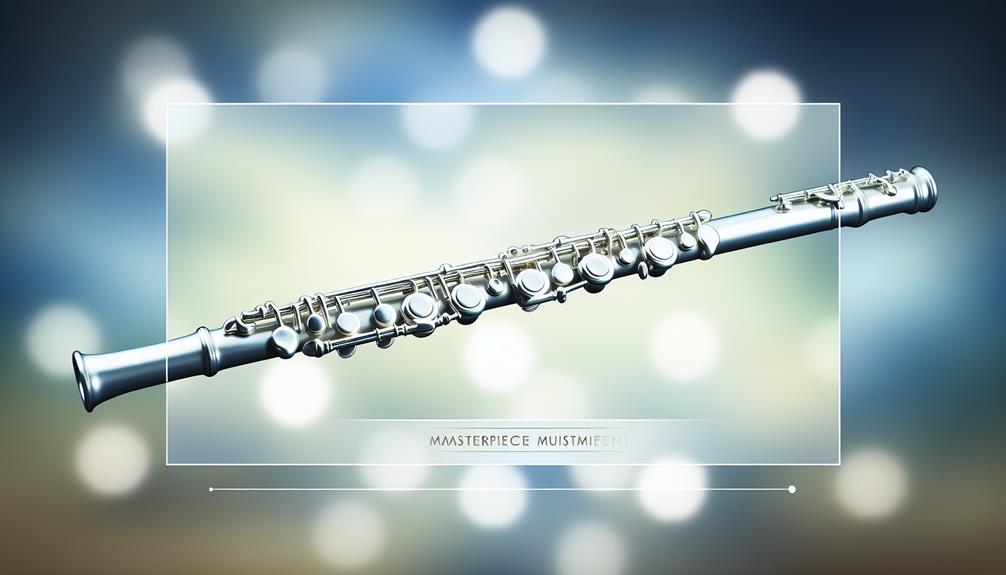When considering the realm of flutes, one may ponder which particular type holds the title of the most common.
A glance at the landscape of musical genres reveals a diverse array of flutes, each with its unique characteristics and appeal.
From the elegant presence in classical compositions to the spirited improvisations in jazz settings, flutes play vital roles across various musical contexts.
Furthermore, their accessibility and versatility make them a prevalent choice for musicians at all levels of expertise.
As we explore the nuances of flutes and their prevalence, one may find themselves drawn to uncover the flute that stands as the most ubiquitous in the musical world.
Key Takeaways
- The Western concert flute is the most common type of flute.
- Other types include piccolo, alto flute, and bass flute.
- The concert flute is widely used in classical music.
- Different flutes offer varying pitch ranges and tones.
Different Types of Flutes
Among the diverse family of flutes, various types exist, each distinguished by unique features and characteristics. The most common type of flute is the Western concert flute, also known as the transverse flute. This flute is often made of silver, gold, or other metals, and is played horizontally by blowing across the mouthpiece.
Another popular type is the piccolo, which is smaller in size and produces a higher pitch than the concert flute. The alto flute is larger and produces a richer, deeper sound, adding variety to flute ensembles.
Additionally, the bass flute, even larger than the alto flute, offers a lower range of notes, enhancing the depth of orchestral compositions. Other less common types include the fife, the fujara, and the ocarina, each with its own unique history and cultural significance.
Understanding the different types of flutes can broaden one's appreciation for the instrument's versatility and the diverse musical traditions it represents.
Popularity in Classical Music
The flute's prominence in classical music performances underscores its enduring appeal and versatility within orchestral compositions. Its sweet and agile sound has made it a staple in the classical music world, featuring prominently in symphonies, concertos, chamber music, and operas. From the hauntingly beautiful solos in Tchaikovsky's 'Swan Lake' to the lively and intricate melodies in Mozart's 'Flute Concerto in D Major,' the flute's ability to convey a wide range of emotions and styles has solidified its place as a beloved instrument in classical music.
Flutists throughout history, such as Jean-Pierre Rampal and James Galway, have captivated audiences with their virtuosity and artistry, further elevating the flute's status in the classical music realm. Additionally, composers like J.S. Bach, Debussy, and Prokofiev have written iconic pieces that showcase the flute's capabilities, ensuring its continued presence on concert stages worldwide. The flute's agility, expressiveness, and rich history contribute to its enduring popularity and essential role in classical music performances.
Influence in Jazz Ensembles
Flute's adaptability and unique timbre have seamlessly integrated it into the vibrant and dynamic world of jazz ensembles. In jazz, the flute adds a distinct color to the ensemble, blending beautifully with other instruments like the saxophone, trumpet, and piano. Its ability to soar over the rhythm section with agile and melodic lines brings a fresh and airy quality to jazz compositions. Flute players in jazz bands often showcase their virtuosity through improvisation, creating spontaneous and inventive solos that captivate audiences.
The flute's versatility allows it to be featured in various jazz styles, from traditional Dixieland and swing to more modern fusion and Latin jazz. Its presence in jazz ensembles has evolved over time, with notable musicians like Herbie Mann, Hubert Laws, and Yusef Lateef pushing the boundaries of flute performance in jazz. As a result, the flute has become an essential voice in the rich tapestry of sounds that define the world of jazz music.
Role in Modern Pop Bands
With its versatility and unique timbre, the flute has found a significant role in enhancing the sound of modern pop bands. In today's pop music scene, the flute adds a touch of whimsy and sophistication, creating a distinctive sound that sets bands apart. Pop bands often use the flute to bring a fresh and airy quality to their music, adding layers of texture and complexity to their compositions. The flute's ability to play both melodically and rhythmically makes it a valuable asset in crafting catchy hooks and memorable melodies that resonate with audiences.
Moreover, the flute's presence in modern pop bands offers a sense of nostalgia and warmth, evoking feelings of joy and nostalgia in listeners. Its ethereal tones blend seamlessly with other instruments, contributing to the overall richness of the band's sound. In a genre that constantly evolves and experiments with new sounds, the flute's timeless appeal continues to captivate audiences and elevate the music to new heights.
Flute of Choice for Beginners
In introducing beginners to the world of flute playing, selecting an appropriate flute is crucial for fostering a solid foundation in musical education. For novice flutists seeking to embark on their musical journey, the flute of choice often recommended is the student or beginner flute. These flutes are specifically designed with the learning process in mind, featuring features such as a durable construction, easy playability, and affordability.
Beginner flutes typically have a straight headjoint which makes it easier for beginners to produce clear sounds and develop proper playing techniques. They are also crafted from materials like nickel silver or silver-plated brass, striking a balance between quality and cost-effectiveness. Additionally, many beginner flutes come with helpful accessories such as cleaning rods, cases, and tuning rods to assist new players in caring for their instrument and maintaining its optimal performance.
Frequently Asked Questions
What Is the Historical Significance of the Flute in Different Cultures Around the World?
The historical significance of the flute in various cultures worldwide is profound. It has served as a vital instrument in rituals, ceremonies, and music-making traditions, symbolizing cultural identity, spirituality, and artistic expression across diverse societies throughout history.
How Does the Material of the Flute Affect Its Sound and Playability?
The material of a flute directly impacts its sound and playability. Different materials, like silver, gold, or wood, can produce varied tones and responses. Musicians often seek materials that resonate with their artistic expression and technical needs.
Are There Any Health Benefits or Risks Associated With Playing the Flute?
Playing the flute can offer numerous health benefits, such as improved lung capacity, cognitive function, and stress relief. However, poor playing posture or overuse can lead to musculoskeletal issues. Proper training and technique are crucial for maintaining physical well-being.
How Has Technology Influenced the Design and Sound of Modern Flutes?
In the evolution of modern flutes, technology has revolutionized design and sound. Innovations like precision machining, advanced materials, and acoustic research have enhanced playability and tonal qualities, shaping the instruments musicians rely on today.
What Are Some Unique and Unusual Types of Flutes That Are Not Commonly Seen or Heard Of?
Some unique and unusual types of flutes include the contrabass flute, double contrabass flute, and the hyperbass flute. These instruments offer deep and rich tones, expanding the sonic possibilities beyond what is commonly seen and heard.
Conclusion
In conclusion, the silver flute, also known as the Western concert flute, is the most common flute seen across various musical genres. Its versatility and rich sound have solidified its place in classical music, jazz ensembles, and modern pop bands.
Beginners often choose the silver flute as their instrument of choice due to its accessibility and widespread availability.
Like a melodic breeze, the silver flute continues to enchant audiences worldwide with its beauty and grace.

